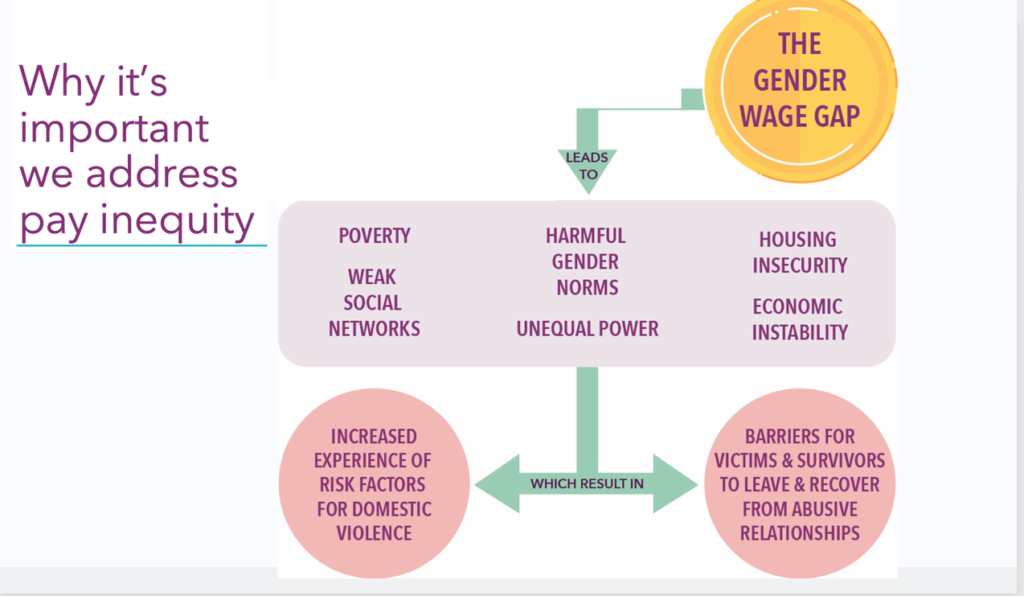March 25 is Equal Pay Day- this day marks how far into the year women must work to earn what men made in the previous year. For women of color, this gap is stretched further. Black women, Latina women, Indigenous women, and other communities whose identities are marginalized must work months longer before reaching the same earningsi. This is reflected in the different Equal Pay Days, which mark how much longer women of color must work to catch up:
2025 Equal Pay Day Calendar:
- All Women’s Equal Pay Day – March 25th
- Asian American, Native Hawaiian, and Pacific Islander (AANHPI) Women’s Equal Pay Day – April 7th
- Moms’ Equal Pay Day – May 6th
- LGBTQIA+ Equal Pay Awareness Day – June 17th
- Black Women’s Equal Pay Day – July 10th
- Native Hawaiian and Pacific Islander (NHPI) Women’s Equal Pay Day – August 28th
- Latina Equal Pay Day – October 8th
- Disabled Women’s Equal Pay Day – October 23rd
- Native Women’s Equal Pay Day – November 18th
On Equal Pay Day, we talk about pay inequity, the cents on the dollar that women, especially women of color, earn in comparison to White, non-Hispanic men. But what often gets lost in the conversation is how pay inequity can expose someone to cycles of abuse. Pay inequity is much more than an unfair paycheck; it is a systemic barrier that traps survivors in abusive relationships and prevents someone from leaving. It’s not just about fairness; it’s about survival.
The Connection Between Pay Equity and Domestic Violence
Financial abuse is one of the most common, yet least recognized, forms of control in an abusive relationship. Financial abuse occurs in 98% of domestic violence relationships, and it can look like sabotaging a survivor’s job, restricting access to bank accounts, or running up debt in their name, among other tactics.ii

Economic insecurity is one of the biggest reasons survivors stay in or return to their abusers.iii Imagine trying to leave an abusive relationship. If you aren’t earning a living wage or if you are earning less than your male counterparts working the same job, your ability to afford housing, childcare, legal fees, and basic necessities is already compromised—let alone the impact of leaving and losing a second income or losing your job.
For women of color, immigrant women, and single mothers, that gap is even wider, which further worsens their financial well-being.iv When survivors can’t make ends meet on their own, they are forced into an impossible choice: stay in danger or face homelessness, hunger, and poverty.
Pay equity isn’t just a women’s issue—it’s a public safety issue. When women are paid fairly, they have options. They have more resources to leave abusive situations. They can build stability for their children. They can reclaim their futures. And importantly, they would be able to build a secure financial foundation, protecting them from the cycles of poverty, exploitation, and dependence that compromise their safety and well-being in the first place.
Moving Beyond Awareness to Action
Equal Pay Day is more than a date on the calendar; it is a reminder that economic justice and gender-based violence are deeply connected. It’s about recognizing that pay equity can be a lifeline. If we truly want to prevent domestic violence, we must address the systemic inequities that keep survivors financially trapped.v Research shows that when women have access to fair wages and economic opportunities, the risk factors for domestic violence decrease.vi Some key solutions to address pay inequity include:
- Strengthening Pay Transparency Strategies: Requiring employers to share salary ranges in job postings and with staff, banning the salary history question in job applications, and prohibiting repercussions for staff discussing salaries can help close wage gaps and prevent discrimination.vii
- Expanding Paid Leave and Workplace Protections: Survivors often need time off to attend court hearings, secure housing, or even heal. Paid leave policies specifically for domestic violence survivors can make a critical difference.
- Investing in Financial Education: Programs can provide financial education courses for advocates and survivors. Advocates trained in financial literacy can better support survivors in navigating economic abuse, building credit, budgeting, and accessing resources for long-term stability. Providing survivors with financial education workshops and access to asset-building programs can help them break free from financial dependence.
- Paying a Thriving Wage: A thriving wage is the amount of money needed for a person to thrive beyond paycheck-to-paycheck survival. It allows for savings, travel, and hobbies. It provides the economic independence necessary to save and grow wealth. Organizations should aim to provide a thriving wage instead of merely targeting a living wage.
As we recognize this year’s Equal Pay Day, let us move beyond awareness and toward action. When women are paid fairly, they are not just earning a paycheck; they are securing their future.
Let’s start by having a conversation about pay equity. Here’s our pay equity landing page for more information. Feel free to reach out to Aishwarya at as****@***dv.org or Kristen at kh*****@***dv.org to talk more.
Endnotes
- i Economic Policy Institute (2022). Understanding black-white disparities in labor market outcomes requires models that account for persistent discrimination and unequal bargaining power. Retrieved from https://www.epi.org/unequalpower/publications/understanding-black-white-disparities-in-labor-market-outcomes/
- ii National Network to End Domestic Violence. (2023). The intersection of economic abuse and domestic violence. Retrieved from https://nnedv.org
- iii National Network to End Domestic Violence. (2023). About Financial Abuse. Retrieved from https://nnedv.org/content/about-financial-abuse/
- iv National Women’s Law Center. (2023). The wage gap: The who, how, why, and what to do. Retrieved from https://nwlc.org/wp-content/uploads/2019/09/Wage-Gap-Who-how.pdf
- v Institute for Women’s Policy Research. (2022). The economic impact of closing the gender wage gap. Retrieved from https://iwpr.org/wp-content/uploads/2021/05/Economic-Impact-of-Equal-Pay-by-State_FINAL.pdf
- vi Postmus, J. L., Plummer, S. B., & Stylianou, A. M. (2020). Economic empowerment of domestic violence survivors: A longitudinal study. Journal of Interpersonal Violence, 35(1-2), 306-325.
- vii Fitzgerald, M. (2024). More states enact salary transparency laws to fight gender, racial pay gaps. Stateline. Retrieved from https://stateline.org/2024/07/10/more-states-enact-salary-transparency-laws-to-fight-gender-racial-pay-gaps/#:~:text=So%20far%2C%20California%2C%20Colorado%2C,employment%20laws%20for%20large%20companies.